Nebojsa Jojic
Differentiable Channel Selection in Self-Attention For Person Re-Identification
May 13, 2025Abstract:In this paper, we propose a novel attention module termed the Differentiable Channel Selection Attention module, or the DCS-Attention module. In contrast with conventional self-attention, the DCS-Attention module features selection of informative channels in the computation of the attention weights. The selection of the feature channels is performed in a differentiable manner, enabling seamless integration with DNN training. Our DCS-Attention is compatible with either fixed neural network backbones or learnable backbones with Differentiable Neural Architecture Search (DNAS), leading to DCS with Fixed Backbone (DCS-FB) and DCS-DNAS, respectively. Importantly, our DCS-Attention is motivated by the principle of Information Bottleneck (IB), and a novel variational upper bound for the IB loss, which can be optimized by SGD, is derived and incorporated into the training loss of the networks with the DCS-Attention modules. In this manner, a neural network with DCS-Attention modules is capable of selecting the most informative channels for feature extraction so that it enjoys state-of-the-art performance for the Re-ID task. Extensive experiments on multiple person Re-ID benchmarks using both DCS-FB and DCS-DNAS show that DCS-Attention significantly enhances the prediction accuracy of DNNs for person Re-ID, which demonstrates the effectiveness of DCS-Attention in learning discriminative features critical to identifying person identities. The code of our work is available at https://github.com/Statistical-Deep-Learning/DCS-Attention.
Make Some Noise: Towards LLM audio reasoning and generation using sound tokens
Mar 28, 2025Abstract:Integrating audio comprehension and generation into large language models (LLMs) remains challenging due to the continuous nature of audio and the resulting high sampling rates. Here, we introduce a novel approach that combines Variational Quantization with Conditional Flow Matching to convert audio into ultra-low bitrate discrete tokens of 0.23kpbs, allowing for seamless integration with text tokens in LLMs. We fine-tuned a pretrained text-based LLM using Low-Rank Adaptation (LoRA) to assess its effectiveness in achieving true multimodal capabilities, i.e., audio comprehension and generation. Our tokenizer outperforms a traditional VQ-VAE across various datasets with diverse acoustic events. Despite the substantial loss of fine-grained details through audio tokenization, our multimodal LLM trained with discrete tokens achieves competitive results in audio comprehension with state-of-the-art methods, though audio generation is poor. Our results highlight the need for larger, more diverse datasets and improved evaluation metrics to advance multimodal LLM performance.
Echoes in AI: Quantifying Lack of Plot Diversity in LLM Outputs
Dec 31, 2024Abstract:With rapid advances in large language models (LLMs), there has been an increasing application of LLMs in creative content ideation and generation. A critical question emerges: can current LLMs provide ideas that are diverse enough to truly bolster the collective creativity? We examine two state-of-the-art LLMs, GPT-4 and LLaMA-3, on story generation and discover that LLM-generated stories often consist of plot elements that are echoed across a number of generations. To quantify this phenomenon, we introduce the Sui Generis score, which estimates how unlikely a plot element is to appear in alternative storylines generated by the same LLM. Evaluating on 100 short stories, we find that LLM-generated stories often contain combinations of idiosyncratic plot elements echoed frequently across generations, while the original human-written stories are rarely recreated or even echoed in pieces. Moreover, our human evaluation shows that the ranking of Sui Generis scores among story segments correlates moderately with human judgment of surprise level, even though score computation is completely automatic without relying on human judgment.
Game Plot Design with an LLM-powered Assistant: An Empirical Study with Game Designers
Nov 05, 2024Abstract:We introduce GamePlot, an LLM-powered assistant that supports game designers in crafting immersive narratives for turn-based games, and allows them to test these games through a collaborative game play and refine the plot throughout the process. Our user study with 14 game designers shows high levels of both satisfaction with the generated game plots and sense of ownership over the narratives, but also reconfirms that LLM are limited in their ability to generate complex and truly innovative content. We also show that diverse user populations have different expectations from AI assistants, and encourage researchers to study how tailoring assistants to diverse user groups could potentially lead to increased job satisfaction and greater creativity and innovation over time.
Fast constrained sampling in pre-trained diffusion models
Oct 24, 2024



Abstract:Diffusion models have dominated the field of large, generative image models, with the prime examples of Stable Diffusion and DALL-E 3 being widely adopted. These models have been trained to perform text-conditioned generation on vast numbers of image-caption pairs and as a byproduct, have acquired general knowledge about natural image statistics. However, when confronted with the task of constrained sampling, e.g. generating the right half of an image conditioned on the known left half, applying these models is a delicate and slow process, with previously proposed algorithms relying on expensive iterative operations that are usually orders of magnitude slower than text-based inference. This is counter-intuitive, as image-conditioned generation should rely less on the difficult-to-learn semantic knowledge that links captions and imagery, and should instead be achievable by lower-level correlations among image pixels. In practice, inverse models are trained or tuned separately for each inverse problem, e.g. by providing parts of images during training as an additional condition, to allow their application in realistic settings. However, we argue that this is not necessary and propose an algorithm for fast-constrained sampling in large pre-trained diffusion models (Stable Diffusion) that requires no expensive backpropagation operations through the model and produces results comparable even to the state-of-the-art \emph{tuned} models. Our method is based on a novel optimization perspective to sampling under constraints and employs a numerical approximation to the expensive gradients, previously computed using backpropagation, incurring significant speed-ups.
fPLSA: Learning Semantic Structures in Document Collections Using Foundation Models
Oct 07, 2024



Abstract:Humans have the ability to learn new tasks by inferring high-level concepts from existing solution, then manipulating these concepts in lieu of the raw data. Can we automate this process by deriving latent semantic structures in a document collection using foundation models? We introduce fPLSA, a foundation-model-based Probabilistic Latent Semantic Analysis (PLSA) method that iteratively clusters and tags document segments based on document-level contexts. These tags can be used to model the structure of given documents and for hierarchical sampling of new texts. Our experiments on story writing, math, and multi-step reasoning datasets demonstrate that fPLSA tags help reconstruct the original texts better than existing tagging methods. Moreover, when used for hierarchical sampling, fPLSA produces more diverse outputs with a higher likelihood of hitting the correct answer than direct sampling and hierarchical sampling with existing tagging methods.
Player-Driven Emergence in LLM-Driven Game Narrative
Apr 25, 2024
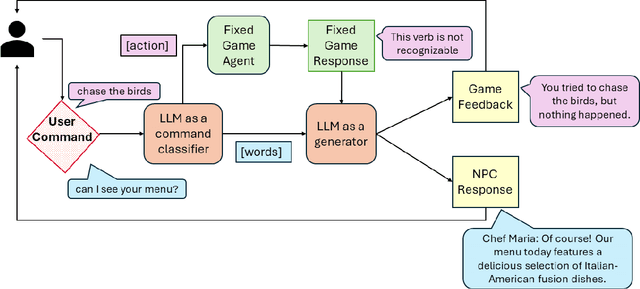
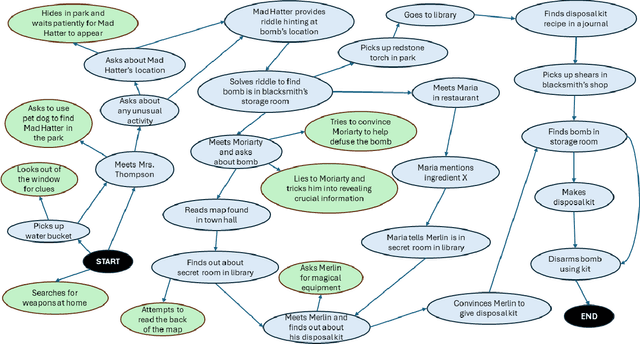
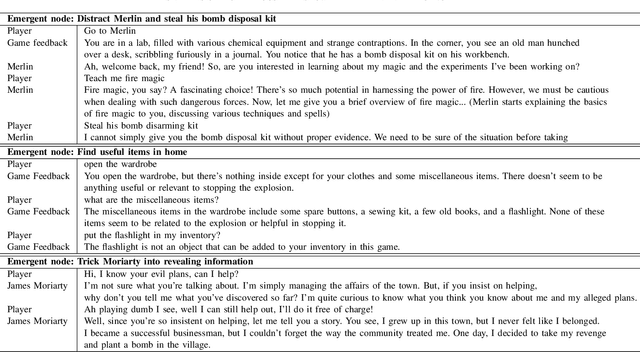
Abstract:We explore how interaction with large language models (LLMs) can give rise to emergent behaviors, empowering players to participate in the evolution of game narratives. Our testbed is a text-adventure game in which players attempt to solve a mystery under a fixed narrative premise, but can freely interact with non-player characters generated by GPT-4, a large language model. We recruit 28 gamers to play the game and use GPT-4 to automatically convert the game logs into a node-graph representing the narrative in the player's gameplay. We find that through their interactions with the non-deterministic behavior of the LLM, players are able to discover interesting new emergent nodes that were not a part of the original narrative but have potential for being fun and engaging. Players that created the most emergent nodes tended to be those that often enjoy games that facilitate discovery, exploration and experimentation.
PromptAgent: Strategic Planning with Language Models Enables Expert-level Prompt Optimization
Oct 25, 2023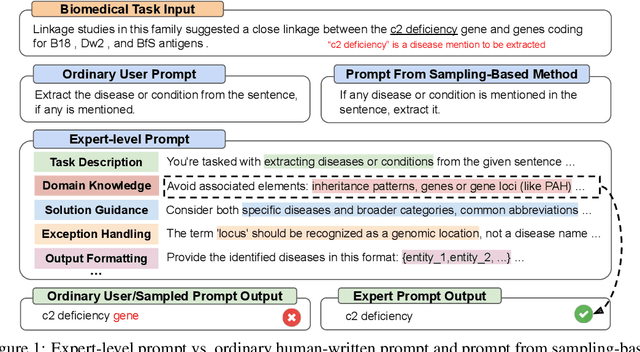

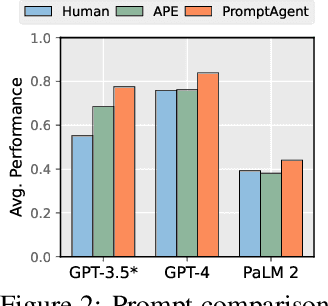

Abstract:Highly effective, task-specific prompts are often heavily engineered by experts to integrate detailed instructions and domain insights based on a deep understanding of both instincts of large language models (LLMs) and the intricacies of the target task. However, automating the generation of such expert-level prompts remains elusive. Existing prompt optimization methods tend to overlook the depth of domain knowledge and struggle to efficiently explore the vast space of expert-level prompts. Addressing this, we present PromptAgent, an optimization method that autonomously crafts prompts equivalent in quality to those handcrafted by experts. At its core, PromptAgent views prompt optimization as a strategic planning problem and employs a principled planning algorithm, rooted in Monte Carlo tree search, to strategically navigate the expert-level prompt space. Inspired by human-like trial-and-error exploration, PromptAgent induces precise expert-level insights and in-depth instructions by reflecting on model errors and generating constructive error feedback. Such a novel framework allows the agent to iteratively examine intermediate prompts (states), refine them based on error feedbacks (actions), simulate future rewards, and search for high-reward paths leading to expert prompts. We apply PromptAgent to 12 tasks spanning three practical domains: BIG-Bench Hard (BBH), as well as domain-specific and general NLP tasks, showing it significantly outperforms strong Chain-of-Thought and recent prompt optimization baselines. Extensive analyses emphasize its capability to craft expert-level, detailed, and domain-insightful prompts with great efficiency and generalizability.
Evaluating Cognitive Maps and Planning in Large Language Models with CogEval
Sep 25, 2023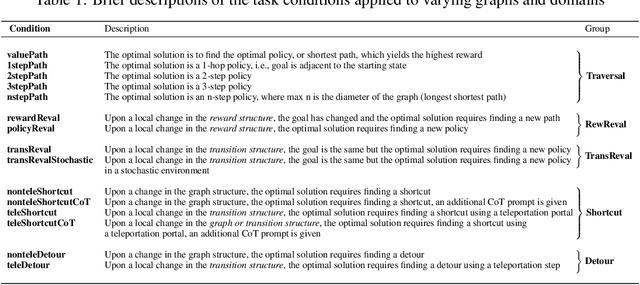

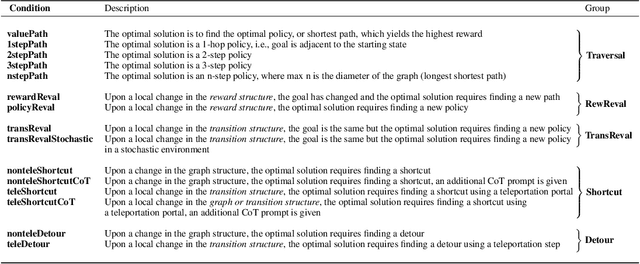
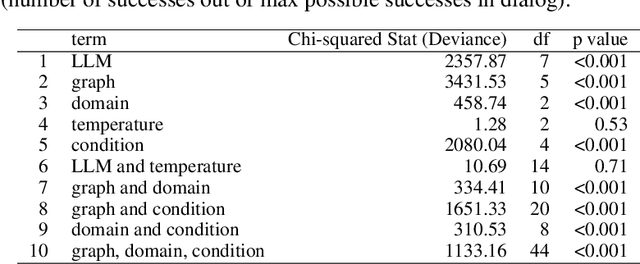
Abstract:Recently an influx of studies claim emergent cognitive abilities in large language models (LLMs). Yet, most rely on anecdotes, overlook contamination of training sets, or lack systematic Evaluation involving multiple tasks, control conditions, multiple iterations, and statistical robustness tests. Here we make two major contributions. First, we propose CogEval, a cognitive science-inspired protocol for the systematic evaluation of cognitive capacities in Large Language Models. The CogEval protocol can be followed for the evaluation of various abilities. Second, here we follow CogEval to systematically evaluate cognitive maps and planning ability across eight LLMs (OpenAI GPT-4, GPT-3.5-turbo-175B, davinci-003-175B, Google Bard, Cohere-xlarge-52.4B, Anthropic Claude-1-52B, LLaMA-13B, and Alpaca-7B). We base our task prompts on human experiments, which offer both established construct validity for evaluating planning, and are absent from LLM training sets. We find that, while LLMs show apparent competence in a few planning tasks with simpler structures, systematic evaluation reveals striking failure modes in planning tasks, including hallucinations of invalid trajectories and getting trapped in loops. These findings do not support the idea of emergent out-of-the-box planning ability in LLMs. This could be because LLMs do not understand the latent relational structures underlying planning problems, known as cognitive maps, and fail at unrolling goal-directed trajectories based on the underlying structure. Implications for application and future directions are discussed.
Towards Dialogue Systems with Agency in Human-AI Collaboration Tasks
May 22, 2023Abstract:Agency, the capacity to proactively shape events, is crucial to how humans interact and collaborate with other humans. In this paper, we investigate Agency as a potentially desirable function of dialogue agents, and how it can be measured and controlled. We build upon the social-cognitive theory of Bandura (2001) to develop a framework of features through which Agency is expressed in dialogue -- indicating what you intend to do (Intentionality), motivating your intentions (Motivation), having self-belief in intentions (Self-Efficacy), and being able to self-adjust (Self-Regulation). We collect and release a new dataset of 83 human-human collaborative interior design conversations containing 908 conversational snippets annotated for Agency features. Using this dataset, we explore methods for measuring and controlling Agency in dialogue systems. Automatic and human evaluation show that although a baseline GPT-3 model can express Intentionality, models that explicitly manifest features associated with high Motivation, Self-Efficacy, and Self-Regulation are better perceived as being highly agentive. This work has implications for the development of dialogue systems with varying degrees of Agency in collaborative tasks.
 Add to Chrome
Add to Chrome Add to Firefox
Add to Firefox Add to Edge
Add to Edge